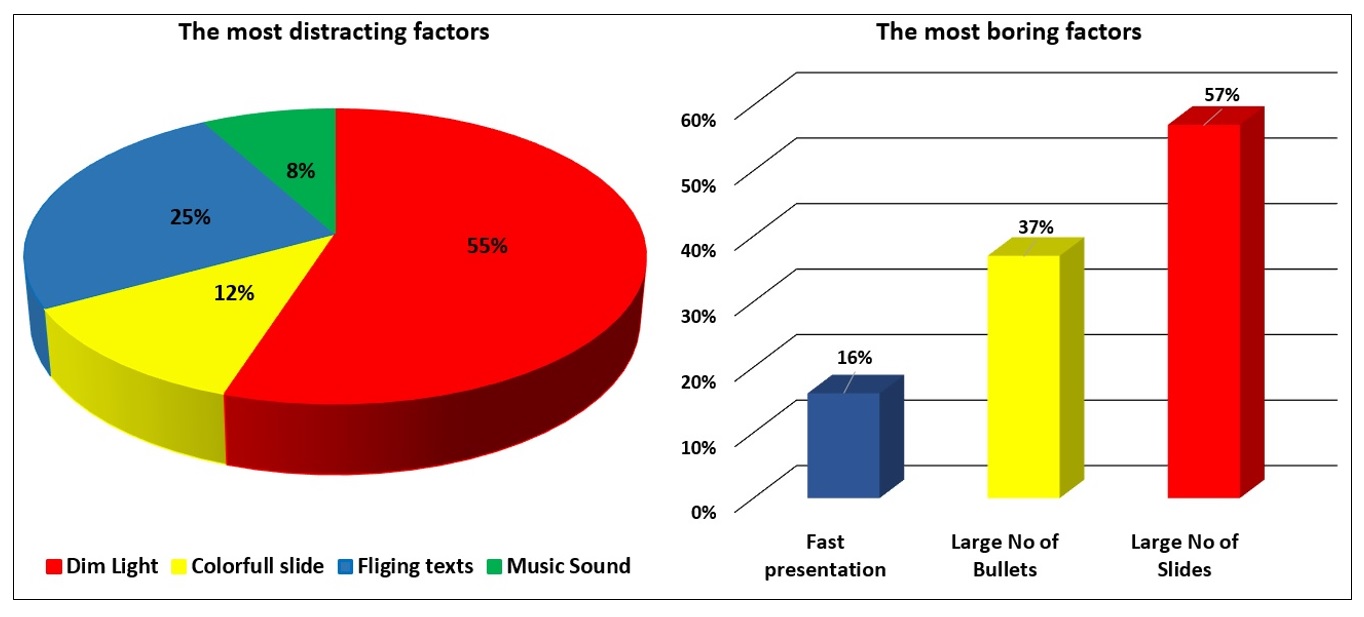


Theme
Educational Environments
INSTITUTION
Najran University, Faculty of Medicine

PowerPoint is a simple program now can be found on approximately 250 million computers worldwide, thirty million PowerPoint presentations take place each a day; despite of that, PowerPoint has been widely criticized as an ineffective tool for communication and learning.
Objective: The objective of this study was to find out the limitations of the PowerPoint presentations in teaching medical students.
Material and Methods: This is a descriptive cross-sectional study conducted at Faculty of Medicine in Najran University in Saudi Arabia, aiming at describing some of the disadvantages of the PowerPoint presentations from the student’s point of views. Only Medical students were included voluntary. A questionnaire designed including demographic data along with other data about PowerPoint presentations. One hundred and ten students participated, data was collected, statistical analysis using SPSS program was done.
The Result: Out of (n=110), 95(86%) students believe that PowerPoint presentations have a lot of pitfalls and limitations, and approximately half of the whole group 57(52%) reported that the most boring factor in the presentations were the large number of slides being presented, 60(54%) of the studied population considered the dim light as the first distracting factor, while 28(25%) said the flying text or slides during changing to the next one is the most distracting factor. 74(67%) of the group reported that twenty to thirty slides per one hour presentation is a quite suitable slides number in the presentations. Additionally, 73(66%) quoted that only six bullets in one slide were a quite suitable for effective presentation. Finally 83(75%) of the whole group stated that mixing PowerPoint with conventional method of whiteboard chalks and talks is the most effective method of teaching.

Student's response to the most boring factors & the suitable numbers of slides and bullets
|
Question |
Answer options |
Frequency |
Percentage |
|
The most boring factor is?
|
Large number of slides |
57 |
51.8% |
|
Large number of bullets |
37 |
33.6% |
|
|
Fast presentation |
16 |
14.5% |
|
|
The suitable Numbers of slides in one-hour presentation is?
|
10-20 slides |
27 |
24.5% |
|
20-30 slides |
74 |
67.3% |
|
|
30-40 slides |
9 |
8.2% |
|
|
The suitable numbers of bullets is? |
Three bullets |
7 |
6.4% |
|
Six bullets |
73 |
66.4% |
|
|
Nine bullets |
28 |
25.5% |
|
|
Twelve bullets |
2 |
1.8% |
From the student’s point of view, the authors concluded that PowerPoint presentation have a lot of limitation and pitfalls. Also concluded that using the integrated method of chalks and talks in association with PowerPoint presentation makes it preferable for the students
For effective interactive PowerPoint presentation the following recommendations must be kept in mind and followed:
-
Avoiding too many animations, as this can distract the audience, and if you want to use animations, use the same type for all slides, for example, don't have text "fly” from the bottom of one slide, then from the top on the next slide, and so on.
-
The 6-by-6 rule should be Followed: On any given slide use no more than six bullet points and no more than six words per bulleted statement.
-
Dim light should be avoided if possible because it may provide a relaxing atmosphere
-
Using integrated method of chalks and talks in association with the slide show and keep good nonverbal communication with the audience by using facial expression, hands gesture, and voice tone in a proper way and time.
We would like to thank the administration of the College of Medicine in Najran University for thier unlimited help, and also we would like to thank all the students who participate in the study.
Abdul-Aziz Hassan, Isa Usman, Sani Awwalu (2014).Impact of Power-Point Presentation on the Academic Performance of Medical Students of Ahmadu Bello University Zaria. Sub-Saharan African Journal of Medicine, 2: 3–7.
April Savoya, Robert W. Proctorb (2009). Information retention from PowerPoint™ and traditional lectures. Computers& Education, 52 (4): 858–867.
AxtellK, Maddux C and Aberasturi S (2008). The effect of presentation software on classroom verbal interaction and on student retention of higher education lecture content. International Journal of Technology in Teaching and Learning, 4(1):21–33.
Cooper, Singe S, Yoder Wise PS, (2003). Teaching with slides, Power-Point, and overhead projectors. J Contin Educ Nurs, 34:24–6.
Ding Xingeng, Liu Jianxiang (2012). Advantages and Disadvantages of PowerPoint in Lectures to Science Students. I.J. Education and Management Engineering, 9:61-65.
Jennifer M. Appersona, Eric L. Lawsa (2008). An assessment of student preferences for PowerPoint presentation structure in undergraduate courses. Computers & Education, 50(1): 148–153.
Lois A. Jordan (2014). PowerPoint®: It’s not “Yes” or “No” - it’s “When” and “How” Research in Higher Education Journal, 22: 1–13.
Meo SA, Shahabuddin S, Al Masri AA (2013). Comparison of the impact of PowerPoint and chalkboard in undergraduate medical teaching: an evidence based study. AM. - J Coll Physicians Surg Pak, 23 (1): 47-50
Mustafa Akdag and Hidayet Tok, (2008). The Effects of Traditional Instruction and PowerPoint Presentation-Supported Instruction on Student’s Achievement. Education and Science, 33(147):26-34.
Petroski henry (2004). Chaning Slides, ASEE Prism, 13(7): 22-26. Rick Penciner (2013). Does PowerPoint enhance learning?. CJEM,
15(2): 109-112.
Rodney M. Schmaltz and Rickard Enstrom, (2014). Death to weak PowerPoint: strategies to create effective visual presentations. Frontiers in Psychology, 5, Article 1138, 1-4.
Russell J. Craig and Joel H. Amernic (2006). PowerPoint Presentation Technology and the Dynamics of Teaching. Innov High Educ,
31:147–160.
Sansgiry, Sujit S, Bhosle (2004). Students' Attitudes Toward Power-Point Timed Quizzes. American Journal of Pharmaceutical Education, 68: 1-5.
Sloboda (2003). Brian Creating effective PowerPoint presentations Management Quarterly. ProQuest Central, 44 (1): 20-24.
Tresa Kaur Dusaj (2013). Pump up your PowerPoint[R] presentations: effective use of visual aids promotes audience engagement. American Nurse Today, 8 (7): 43-47.
 Send Email
Send Email